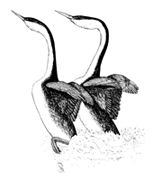Papers in the Biological Sciences

Diving Birds of North America by Paul A. Johnsgard
Date of this Version
April 1987
Document Type
Book
Abstract
Considering the great nostalgic attraction of such birds as the common loon for people who have lived at least part of their lives around the lakes of Canada and the northern United States, and given the endearing visual appeal of species like puffins and auklets, it is rather surprising that there are so few books on these groups of aquatic birds. During my childhood summers at our Minnesota lake cottage I used to spend hours watching loons and red-necked grebes, and I marveled at their wonderful diving ability and powerful voices. Much later, the wild puffins and massed breeding colonies of murres along the rugged coasts of Scotland and Alaska were some of the most memorable sights of my entire life. In trying to learn more about these wonderful species I found myself forced repeatedly to turn to A. C. Bent's classic Life Histories of Northern American Diving Birds. This book, published in 1919, was the first in Bent's long and distinguished series of authoritative references. Yet it provided a frustratingly small amount of biological information, since at the time very little was known of the breeding biology and ecology of most of these elusive species.
At about the same time Bent's book was published, ornithologists taxonomically isolated the auks from the loons and grebes. Researchers thus ceased to deal collectively with these three groups, and the birds' generally remote nesting sites, as well as the minimal economic significance of most, caused them to be relatively neglected by ornithologists. Each summer as I returned to Minnesota and was excited by the sights and sounds of breeding grebes and loons, I wondered if a book dealing with them might not be worthwhile. But it was not until the late 1970s, after I had seen several of the auks on their nesting grounds, that I began to think in terms of dealing collectively with all the North American "diving birds," in spite of the artificial "lumping" this approach would require. As I considered it further, it seemed that such coverage would emphasize the impact of convergent and parallel evolution better than would dealing with the patterns of adaptive radiation within a single phyletic group as has been the typical approach of my earlier books.
This vision became stronger after a trip to the seabird colonies on the Pribilof Islands in 1982, and soon thereafter I began organizing references for my book. In attempting to learn if any works on the same subject area were in the offing, I eventually discovered that Dr. Asa C. Thoreson had nearly finished a book on the auks of the world. When I wrote to him it became apparent that our planned books were oriented in rather different ways. In any case, none of the comparative aspects of diving bird biology would be dealt with by his book, which consists almost exclusively of species accounts. Thus I went ahead with my project and was further aided by Dr. Thoreson, who very kindly sent me a photocopy of his text, which greatly helped me in my own work and allowed me to avoid unnecessary overlap with his.
[This electronic edition contains the entire work as originally published, including the photograph sections, and is accordingly a rather large file. Each individual chapter, as well as the species accounts for loons, grebes, and auks, may also be accessed separately if desired.]


Comments
From Diving Birds of North America (1987) by Paul A. Johnsgard. Copyright © 2007 Paul Johnsgard. Cite this work as: Paul Johnsgard, Diving Birds of North America (Lincoln, Nebraska: University of Nebraska Press, 1987; University of Nebraska–Lincoln Libraries, 2008 [ebook edition]).